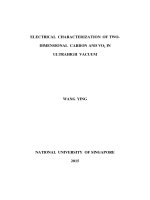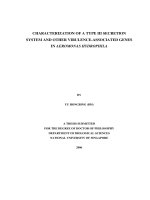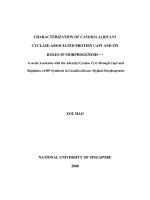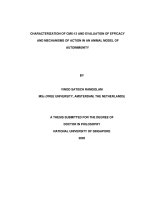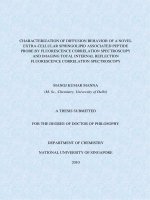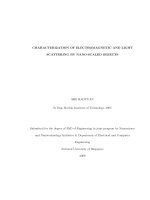Fabrication and characterization of nanostructured half metals and diluted magnetic semiconductors
Bạn đang xem bản rút gọn của tài liệu. Xem và tải ngay bản đầy đủ của tài liệu tại đây (14.15 MB, 208 trang )
FABRICATION AND CHARACTERIZATION OF
NANOSTRUCTURED HALF METALS AND DILUTED
MAGNETIC SEMICONDUCTORS
LI HONGLIANG
NATIONAL UNIVERSITY OF SINGAPORE
2006
FABRICATION AND CHARACTERIZATION OF
NANOSTRUCTURED HALF METALS AND DILUTED
MAGNETIC SEMICONDUCTORS
LI HONGLIANG
(M. Eng., Tongji University, P. R. China)
A THESIS SUBMITTED
FOR THE DEGREE OF DOCTOR OF PHILOSOPHY
DEPARTMENT OF ELECTRICAL AND COMPUTER ENGINEERING
NATIONAL UNIVERSITY OF SINGAPORE
2006
Acknowledgements
i
ACKNOWLEDGEMENTS
First of all, I would like to express my sincere gratitude to my supervisor, A/P
Wu Yihong, for his guidance and constant encouragement throughout this project. His
invaluable discussions and explanations about the complicated experimental results
always let me on the right way in my research work. It is impossible to finish this
project without him. I am very impressed for his diligence, scientific research attitude,
and acute sense to development trends in the nanospintronic field.
I am grateful to my two co-supervisors, A/P Teo Kie Leong and Dr. Guo
Zaibing, for their kind help and valuable advices over the entire course of my Ph.D.
project. Specially, Dr. Guo Zaibing gave me great help in the magnetic properties
measurements.
I am greatly indebted to Dr. Wang Shijie and Mr. Liu Binghai for the
preparation and observation of TEM samples. The TEM results are very important for
the publication of my journal papers.
Sincere thanks should also go to all the staffs in nanospin electronics laboratory,
data storage institute. They have helped me in one way or another in my studies and
daily life. I also want to acknowledge the excellent experimental and study
environment provided by both data storage institute and national university of
Singapore.
Acknowledgements
ii
I deeply thank other students in our group for their valuable help in my research
work, and their friendship and happy time spent with them throughout four-year
studies.
Forever, great heartfelt thanks to my family: my parents, my wife, my daughter,
and my relatives for their firm support and everlasting love, which is my impetus to
finish four-year Ph.D. studies and optimistically face all kinds of challenges in my life.
In particular, my wife has accompanied me almost throughout four-year Ph.D. studies
and taken the responsibility alone to look after our lovely daughter.
Table of contents
iii
TABLE OF CONTENTS
Acknowledgements i
Table of contents iii
Abstract viii
List of tables xi
List of figures xii
Nomenclature xxii
Acronyms xxiv
List of publications xxvi
Chapter 1 Introduction and literature survey 1
1.1 Background 1
1.2 Magnetoelectronics 2
1.2.1 GMR effect and spin-polarized transport 2
1.2.2 Spin valves 4
1.2.3 Magnetic tunneling junctions 5
1.2.4 Half-metallic materials and classification 7
1.3 Semicondcutor-based spintronics 10
1.3.1 Diluted magnetic semiconductors 10
1.3.2 Classification of diluted magnetic semicondcutors 11
1.3.3 Ferromagnetism origin in diluted magnetic
semicondcutors
14
1.4 Objectives and motivation 16
1.5 Organization of this thesis 17
Table of contents
iv
Chapter 2 Fabrication and characterization of Fe
3
O
4
nanostructures
28
2.1 Introduction 28
2.2 Experiments 34
2.2.1 Experimental setup 34
2.2.2 Experimental details 35
2.3 Results and discussion 37
2.3.1 Structural properties 37
2.3.2 Magnetic properties 38
2.3.3 Electrical transport properties 41
2.3.4 Our model to explain the experimental results 51
2.4 Summary 52
Chapter 3 Magnetic and electrical transport properties of
amorphous Ge
1-x
Mn
x
thin films
59
3.1 Introduction 59
3.2 Experiments 63
3.3 Results and discussion 65
3.3.1 Structural and surface morphology properties 65
3.3.2 Magnetic properties 67
3.3.2.1 M-H curves 67
3.3.2.2 ZFC, FC and TRM 70
3.3.2.3 High temperature phase 74
3.3.2.4 Relaxation 80
3.3.2.5 Ac susceptibility 81
3.3.2.6 Our model for the explanation of the observed 87
Table of contents
v
abnormal magnetic phenomena
3.3.2.7 Effect of H
2
plasma annealing 89
3.3.3 Electrical transport properties 93
3.3.3.1 Temperature-dependent resistivity 93
3.3.3.2 Temperature-dependent conductance 95
3.3.3.3 Magnetoresistance effect 97
3.3.3.4 Hall effect 99
3.4 Summary 103
Chapter 4 Magnetism and electrical transport properties of
amorphous Ge
1-x
Mn
x
thin films embedded with Ge crystallites
and high T
C
secondary phases and granular Ge
0.74
Mn
0.26
thin
films
112
4.1 Introduction 112
4.2 Experimental details 113
4.3 Results and discussion 115
4.3.1 Structural and surface morphology properties 115
4.3.2 Magnetic properties 119
4.3.3 Electrical transport properties 124
4.3.3.1 Temperature-dependent resistivity 124
4.3.3.2 Temperature-dependent conductance 125
4.3.3.3 Magnetoresistance effect 127
4.3.4 Electrical transport properties for Ge:Mn nanowires 129
4.3.4.1 Temperature-dependent resistivity 129
4.3.4.2 Temperature-dependent conductance 130
4.3.5 Ge
0.74
Mn
0.26
granular thin film 135
4.3.5.1 Introduction 135
Table of contents
vi
4.3.5.2 Structural properties 136
4.3.5.3 Magnetic properties 137
4.3.5.4 Electrical transport properties 139
4.4 Summary 142
Chapter 5 Magnetic and electrical transport properties of δ-
doped amorphous Ge
1-x
Mn
x
thin films
147
5.1 Introduction 147
5.2 Experimental details 148
5.3 Results and discussion 148
5.3.1 Structural properties 148
5.3.2 Electrical transport properties 151
5.3.3 Magnetic properties 153
5.3.4 Ordering temperature (T
*
C
) 160
5.4 Summary 162
Chapter 6 A spin valve with amorphous Ge
0.67
Mn
0.33
thin film
as one of electrodes
165
6.1 Introduction 165
6.2 Experimental details 167
6.3 Results and discussion 168
6.3.1 M-H curves 168
6.3.2 Electrical transport properties 169
6.4 Summary 172
Chapter 7 Conclusions and recommendation for future work
175
Table of contents
vii
7.1 Conclusions 175
7.2 Recommendation for future work 177
Abstract
viii
ABSTRACT
The performance of existing metal-based spintronic devices is limited primarily
by two factors: low polarization of the ferromagnetic materials used to build the
devices and inability to control charge motion in metals. The former can be resolved
by using suitable half metals and the latter can be overcome if room temperature
diluted magnetic semiconductors exist. This work has attempted to grow and
characterize two types of potential materials for future spintronic devices: Fe
3
O
4
and
Ge
1-x
Mn
x
. The former is a kind of half metal, while the latter a Ge-based diluted
magnetic semiconductor.
The work on Fe
3
O
4
was focused on the understanding of electrical transport
mechanism across antiphase boundaries through processing the thin film into
nanowires and then studying their transport properties. Prior to this work, intensive
studies have been carried out on the preparation and characterization of Fe
3
O
4
thin
films and their application in spin valves and magnetic tunnel junctions. However, the
magnetoresistance ratio of Fe
3
O
4
-based spintronic devices was significantly lower than
the value which one would expect if the Fe
3
O
4
thin films employed were fully
polarized half metals. Through detailed dynamic conductance measurements, we were
able to reveal that the poor performance of Fe
3
O
4
-based spintronic devices obtained so
far was mainly caused by the low average polarization due to the existence of
randomly distributed antiphase boundaries. We further revealed that the electrical
transport mechanism across the antiphase boundaries was dominated by tunnelling,
Abstract
ix
through detailed studies on nanowires samples. A model was proposed to account for
the experimental results.
The work on Ge
1-x
Mn
x
was focused on understanding of the origin of
ferromagnetism in this material system. Prior to this work, near or above room
temperature ferromagnetism in Ge
1-x
Mn
x
has been reported by several groups.
However, the mechanism of ferromagnetic ordering is still controversial. In this study,
amorphous Ge
1-x
Mn
x
thin films with or without secondary phases, granular thin films,
and δ-doped amorphous thin films have been fabricated and characterized.
The amorphous samples were found to consist of a low-temperature highly
ordered spin-glass-like phase and a high-temperature cluster dopant phase. The
magnetization of the low-temperature phase was found to be coupled
antiferromagnetically with that of the high-temperature phase, leading to the
appearance of a negative thermal remanent magnetization. Detailed magnetic and
electrical transport measurements revealed that the low-temperature highly ordered
spin-glass-like phase consists of both spin-glass-like phase and ferromagnetically
ordered regions. The amorphous samples also exhibited a negative magnetoresistance
and an anomalous Hall effect at low temperatures.
The samples grown at 300
o
C were found to consist of amorphous Ge
1-x
Mn
x
, Ge
crystallites, and high T
C
secondary phases. These samples were ferromagnetic near or
above room temperature and exhibited a positive MR effect. There was no anomalous
Hall effect observed in these samples. Electrical transport across the interface between
high T
C
secondary phases and the host semiconductor matrix was studied in
Ge
0.88
Mn
0.12
nanowires with different diameters. Although the existence of a Schottky
barrier at the nanoparticle / host matrix interfaces and carrier localization at low
Abstract
x
temperatures were observed, the transport across the interfaces was of spin-
independent nature.
In the δ-doped amorphous Ge
1-x
Mn
x
thin films, it was found that the spacing
between magnetic impurities had a strong effect on the magnetic properties. The
electrical transport properties and ordering temperature (T
*
C
) were found to be closely
related to both the Mn concentration and the ratio of Ge and Mn layer thicknesses.
In spite of the large structural differences, one common result observed for these
materials was that the T
*
C
values were very close to those reported for epitaxially
grown samples. This suggested that the so-called Curie temperature reported in
literature was not an indicator of global ordering but rather the ordering temperature of
magnetic clusters in the Ge
1-x
Mn
x
system.
Some preliminary results were also obtained for a spin valve with amorphous
Ge
0.67
Mn
0.33
as one of the electrodes. Typical spin-valve-like M-H curves were
obtained in this structure.
List of tables
xi
LIST OF TABLES
Table 1.1 Some half-metallic materials and their properties 8
Table 1.2 The list of some milestones in the DMSs research 12
Table 2.1 Various preparation methods for Fe
3
O
4
thin films 30
Table 2.2 Device application of Fe
3
O
4
thin films 31
Table 3.1 Literature review about the research work on Ge:Mn 60
Table 3.2 Details of the samples under study in this chapter 64
Table 4.1 The parameters of the samples studied in this chapter 114
Table 5.1 Growth conditions and parameters of the δ-doped amorphous
Ge:Mn samples
149
List of figures
xii
LIST OF FIGURES
FIG. 1.1 Schematic representation of spin-polarized transport from a
ferromagnetic metal, through a nonmagnetic metal, into the
second ferromagnetic metal. [After G. A. Prinz, 1998, Ref. 3]
3
FIG. 1.2 Schematic illustration of the density of states at the Fermi level
for different kinds of half metals. [After J. M. D. Coey, 2004,
Ref. 23]
9
FIG. 1.3 Computed values of the Curie temperature T
C
for various p-
type semiconductors containing 5% of Mn and 3.5
×
10
20
holes
per cm
3
. [After T. Dietl, 2000, Ref. 57]
12
FIG. 1.4 Classification of DMSs materials.
13
FIG. 1.5 Illustration of the mechanism of the carrier-induced
ferromagnetism in diluted magnetic semiconductors. [After A.
H. Macdonald, 2005, Ref. 75]
15
FIG. 1.6 Interaction of two bound magnetic polarons. The polarons are
shown with gray circles. Small and large arrows show
impurity and hole spins, respectively. [After S. D. Sarma,
2002, Ref. 76]
15
FIG. 2.1 1/4 Fe
3
O
4
unit cell of inverse spinal structure. A and B sites
are tetrahedral and octahedral position, respectively. [Ref. 1]
28
FIG. 2.2 Schematic representation of the formation of antiphase
boundaries of a Fe
3
O
4
film on MgO (100) substrate. [After F.
C. Voogt, 1998, Ref. 40]
33
FIG. 2.3 Schematic illustration to show the electrical transport
difference between (a) a thin film and (b) a nanowire, where
33
List of figures
xiii
the solid black and red lines denote the antiphase boundaries
and current direction, respectively.
FIG. 2.4 Schematic diagram of EW-5 MBE system.
34
FIG. 2.5 Schematic illustration of the fabrication process of Fe
3
O
4
nanowires.
36
FIG. 2.6 FIB images of Fe
3
O
4
nanoconstrictions with a width of (a) 150
nm and (b) 80 nm, and a length of 1 µm.
36
FIG. 2.7 XRD pattern of Fe
3
O
4
thin films. Inset: the rocking curve of
(222) peak.
37
FIG. 2.8 (a) Plane-view dark-field high resolution TEM image of Fe
3
O
4
thin films. The black lines are antiphase boundaries; (b)
magnified APBs as indicated by the arrow.
38
FIG. 2.9 ZFC and FC curves of Fe
3
O
4
thin films with an applied
magnetic filed of 100 Oe. The direction of the magnetic field
is along the sample plane.
39
FIG. 2.10 M-H curves of Fe
3
O
4
thin films at different temperatures.
40
FIG. 2.11
Temperature-dependent coercivity (
c
H ) and remanence (
r
M
)
of Fe
3
O
4
thin films.
40
FIG. 2.12 Parallel and perpendicular
M-H
loops at 300 K of Fe
3
O
4
thin
films.
41
FIG. 2.13 Normalized
R-T
curves for both a thin film and a nanowire.
The inset shows the dependence of resistance on
4/1−
T
for
both a thin film and a nanowire.
42
FIG. 2.14 Normalized MR curves for both thin films and nanowires at
300 K (Nanowire_P: field parallel to the wire axis;
Nanowire_V: field perpendicular to the nanowire axis.
43
FIG. 2.15 MR ratios of the original nanowire and nanoconstriction. 1:
original nanowire with a diameter of 300 nm; 2: nanowire after
first FIB etching with a nanoconstriction of 150 nm; 3:
nanowire after second FIB etching with a nanoconstriction of
44
List of figures
xiv
80 nm.
FIG. 2.16
Dependence of
0
/
RR
H
at various temperatures of a Fe
3
O
4
nanowire.
45
FIG. 2.17 Temperature-dependent MR ratios of a nanowire at different
applied magnetic fields.
46
FIG. 2.18 Bias dependence of differential conductance for a nanowire at
130 K with applied magnetic fields of 0 and 5 T, respectively.
Solid curve: fitted data according to the Simmons equation.
Solid circles: experimental data at zero field; open circles:
experimental data at 5 T.
47
FIG. 2.19 Bias dependence of G´ at 130 K.
48
FIG. 2.20 Normalized dynamic conductance-voltage curves of Fe
3
O
4
thin films at different temperatures. Inset: the normalized
conductance-voltage curve at 60 K
49
FIG. 2.21 Bias dependence of MR for a nanowire at 110, 120, and 130
K. Inset: comparison of bias dependence of MR for the thin
film (solid circles) and nanowire (open circles) at 110 K.
50
FIG. 2.22 MR ratio curve at 130 K fitted to a V
2
dependence.
51
FIG. 2.23 A simple model to explain the experimental results: (a) spin
distribution at different situations, (b) spatial profile of
tunnelling barrier.
52
FIG. 3.1 Schematic illustration of the process flowchart for a Hall bar
fabrication. The arrow in (i) indicates the current direction.
64
FIG. 3.2 HRTEM image for sample A4.
65
FIG. 3.3 Raman spectra of samples A1, A2, A3, A4, A6 and bulk Ge.
The dotted lines indicate the peak positions of amorphous Ge
and GaAs substrate at the position of 275, 267 and 292 cm
-1
,
Ge nanocrystal and bulk Ge at the position of around 298 and
301.5 cm
-1
, respectively.
66
List of figures
xv
FIG. 3.4 AFM image for sample A4.
67
FIG. 3.5 Normalized
M-H
curves at 5 K for the samples under study.
68
FIG. 3.6 Temperature dependence of coercivity for sample A5. Insets:
M-H
curves at 10 (above) and 70 K (below).
69
FIG. 3.7 Normalized in-plane and out-of-plane
M-H
loops measured at
5 K for sample A5.
69
FIG. 3.8 Temperature-dependent magnetization curves for the samples
under study with an applied magnetic field of 20 Oe (200 Oe
for A1). (a) Sample A1, (b) sample A2, (c) sample A3, (d)
sample A4, (e) sample A5, and (f) sample A6. The inset in (f)
shows the FC curve at the temperature range from 150 to 300
K.
71
FIG. 3.9 ZFC, FC and TRM curves for sample A5. (a) ZFC curve
(cooled at zero field, measured at 20 Oe); (b) FC curve (cooled
and measured at 20 Oe); (c) TRM (cooled and measured at
zero field); (d) TRM (cooled at 20 Oe from 300 to 5 K,
measured at zero field); (e) TRM (cooled at 20 Oe from 300 to
31 K and at zero field from 31 to 5 K, measured at zero field);
(f) TRM (cooled at 100 Oe from 300 to 5 K, measured at zero
field); (g) TRM (cooled at 1000 Oe from 300 to 5 K, measured
at zero field); (h) TRM (cooled at 5000 Oe from 300 to 5 K,
measured at zero field).
73
FIG. 3.10 ZFC and FC curves for sample A5 with different fitting fields
of 1000 and -2000 Oe before measurements.
74
FIG. 3.11 (a) ZFC and FC curves at different magnetic fields for sample
A4; (b) the ordering temperature
T
*
C
as a function of the
applied magnetic field in sample A4.
76
FIG. 3.12 Normalized
M-T
curves for amorphous samples A1, A2, A3,
A4, and A6 at a magnetic field of 2 T.
78
FIG. 3.13 (a) Simulation results of normalized
M-T
curves with different
79
List of figures
xvi
µ
values (
1.0=
σ
nm and 5.0
=
H T); (b) simulation results
of normalized M-T curves at different applied magnetic fields
(
3=
µ
nm and 1.0
=
σ
nm).
FIG. 3.14 TRM relaxation curves for sample A4 at different
temperatures.
81
FIG. 3.15 Temperature dependence of (a) real part (χ´) and (b) imaginary
part (χ˝) of the ac susceptibility for sample A4 at different
frequencies ranging from 1 to 500 Hz. The inset in (a) shows
the central part of the frequency-dependent shift in χ´.
83
FIG. 3.16 Temperature dependence of (a) real part (χ´) and (b) imaginary
part (χ˝) of the ac susceptibility for sample A4 at different dc
fields and a frequency of 10 Hz.
84
FIG. 3.17 Temperature dependence of the real part (χ´) of the ac
susceptibility with a dc field of 4 Oe at different frequencies
(the black lines) for sample A6. The imaginary part (χ˝) at a
frequency of 10 Hz is also shown in the figure (open circle).
85
FIG. 3.18 Temperature dependence of both (a) real part (χ´) and (b)
imaginary part (χ˝) of the ac susceptibility at different dc fields
and a frequency of 10 Hz for sample A6.
86
FIG. 3.19 Schematic illustration for interpreting the origin of negative
TRM. The spins of the magnetic clusters are shown with gray
circles. The small arrows indicate the spins in the amorphous
Ge
1-x
Mn
x
matrix.
89
FIG. 3.20 FC curves with a magnetic field of 20 Oe for different H
2
plasma annealing time for sample A5.
90
FIG. 3.21 ZFC (open circles) and FC (solid circles) curves at different
magnetic fields for sample A5 after 4 hours H
2
plasma
annealing at 160
o
C.
91
FIG. 3.22 M-H curves at 20, 30 and 70 K for sample A5 after 4 hours H
2
plasma annealing.
93
List of figures
xvii
FIG. 3.23 R-T curves of the samples under study. (a) Sample A2, (b)
sample A3, (c) sample A4, (d) sample A6.
94
FIG. 3.24 Dynamic conductance-voltage curves at different temperatures
for the samples under study. (a) Sample A2, (b) sample A3, (c)
sample A4, (d) sample A6.
96
FIG. 3.25 Temperature-dependent G´ curves for different samples. The
critical point (T
´
C
) is defined as the cross point of the slopes at
high- and low-temperature regions. (a) Sample A2, (b) sample
A3, (c) sample A4, (d) sample A6.
96
FIG. 3.26 (a) MR curves of sample A4 at different temperatures; (b) MR
ratio as a function of temperature for sample A4; (c) MR
curves for samples A2, A3, A4, and A6 at 4.2 K.
98
FIG. 3.27 (a) Hall effect for sample A4 at different temperatures; (b)
coercivity as a function of temperature for sample A4; (c)
normalized temperature dependence of anomalous Hall
resistance for samples A4 and A6; (d) Hall resistance as a
function of temperature at different magnetic fields for sample
A6.
99
FIG. 3.28 Comparison of anomalous Hall resistance at different
temperatures for samples A4 and A6.
101
FIG. 3.29 Carrier densities at different temperatures for samples A4 and
A6.
103
FIG. 4.1 Cross-sectional TEM images of sample Mn24.8%. (a) Dark-
field TEM micrograph of this film. The bright spots enclosed
by white dotted lines are Ge crystallites. The dark areas are the
amorphous Ge
1-x
Mn
x
matrix; (b) HRTEM image of one bight
area in (a). The regions enclosed by white dotted lines show
Ge crystallites with (111) orientation; (c) electron diffraction
pattern taken from one of the bright spots in the dark-field
image. The rings are indexed as 111, 220, and 311 orientations
115
List of figures
xviii
of Ge crystallites. The strong and bright spots are from GaAs
(100) substrate.
FIG. 4.2 Raman spectrum of the samples studied in this chapter. The
arrow points to the lower Mn doping concentrations. The
dotted lines indicate the peak position of Ge nanocrystal at the
position of around 298 cm
-1
116
FIG. 4.3 (a)-(f) AFM images of the samples with different Mn
concentrations.
117
FIG. 4.4 The relation between the surface roughness (R
a
) and Mn
concentrations.
118
FIG. 4.5 (a) and (b) normalized M-T curves of the samples with
different Mn concentrations. The ferromagnetic to
antiferromagnetic transition point for Mn
11
Ge
8
phase is
indicated by the arrow in (a).
119
FIG. 4.6 ZFC and FC curves for sample Mn12% at different applied
magnetic fields.
121
FIG. 4.7 ZFC, FC, ZFC-FC, and TRM curves for sample Mn12% at an
applied magnetic field of 100 Oe.
122
FIG. 4.8 M-H curves for sample Mn12% at different temperatures.
122
FIG. 4.9 M-T curves for samples Mn28.1%, Mn24.8%, and Mn1.5% at
an applied magnetic field of 2 T.
123
FIG. 4.10 R-T curves for the selected samples with different Mn
concentrations. (a) Sample Mn1.5%, (b) sample Mn12%, (c)
sample Mn24.8%, and (d) sample Mn28.1%.
124
FIG. 4.11 Dynamic conductance-voltage curves at different temperatures
for the samples under study. (a) Sample Mn1.5%, (b) sample
Mn24.8%, (c) sample Mn28.1%.
126
FIG. 4.12
Temperature-dependent
'
G
curves for different samples. (a)
Sample Mn1.5%, (b) sample Mn24.1%, and (c) sample
Mn28.1%.
126
List of figures
xix
FIG. 4.13 MR curves for sample Mn24.8% at different temperatures.
128
FIG. 4.14 MR ratios for samples Mn1.5%, Mn24.8%, and Mn28.1% at
different temperatures.
128
FIG. 4.15 Normalized log-scale R-T curves of the thin film, nanowires
with diameters of 5, 1, and 0.1 µm of sample Mn12%.
130
FIG. 4.16 Dynamic conductance-voltage curves for 5 µm nanowire at
different temperature ranges: (a) 5 to 80 K; (b) 80 to 300 K;
(c) 300 to 400 K.
132
FIG. 4.17 Dynamic conductance-voltage curves for 1 µm nanowire at
different temperature ranges: (a) 5 to 145 K; (b) 145 to 305 K;
(c) 315 to 395 K.
133
FIG. 4.18 Dynamic conductance-voltage curves for 0.1 µm nanowire at
different temperature ranges: (a) 5 to 105 K; (b) 105 to 285 K;
(c) 305 to 400 K.
135
FIG. 4.19 Schematic illustration of the granular structure.
136
FIG. 4.20 Bright-field cross-sectional TEM image of the Ge
0.76
Mn
0.24
thin film. The arrow points to a granule with a diameter of ~ 5
nm.
137
FIG. 4.21 ZFC and FC curves measured at an applied magnetic field of
100 Oe at the temperature range from 5 to 320 K for the
granular Ge
0.74
Mn
0.26
thin film.
138
FIG. 4.22 M-H curves measured at 20, 150 and 280 K for the granular
Ge
0.74
Mn
0.26
thin film.
138
FIG. 4.23 Normalized M-H curves at 20 K for the Ge
0.74
Mn
0.26
granular
sample (solid circles), amorphous Ge
0.58
Mn
0.42
sample A5
(open circles), and amorphous Ge
0.58
Mn
0.42
sample A5 after 4
hours H
2
plasma annealing (solid triangles).
139
FIG. 4.24 R-T curve of the granular Ge
0.74
Mn
0.26
thin film at the
temperature range from 5 to 300 K. Inset: the plot of
Rlog
versus
1−
T
.
140
List of figures
xx
FIG. 4.25 (a) Dynamic conductance-voltage curves at different
temperatures for the granular Ge
0.74
Mn
0.26
thin film; (b)
enlarged portion near the zero-bias region below 100 K.
141
FIG. 5.1
Schematic illustration of the
δ
-doped thin film structure.
148
FIG. 5.2 (a) Raman spectra of group B samples. The dotted lines in the
figure indicate the peak positions of amorphous Ge, GaAs
substrate, and Ge crystalline phase at the positions of 275, 292
and 299 cm
-1
, respectively. (b) HRTEM image for sample B1.
150
FIG. 5.3 The relationship between the Mn layer thickness and the
electrical conductivity for different groups of samples studied
in this chapter.
151
FIG. 5.4 Normalized log-scaled R-T curves for group B samples.
152
FIG. 5.5 (a) ZFC and FC curves for samples B1 to B5 at an applied
magnetic field of 20 Oe at the temperature range from 5 to 200
K. (b) Normalized ZFC and FC curves for samples B2 to B5.
154
FIG. 5.6 (a) ZFC and FC curves for group A samples at the temperature
range from 5 to 200 K at a magnetic field of 20 Oe. Inset: ZFC
and FC curves for samples A1 and A2; (b) ZFC and FC curves
for group C samples at the temperature range from 5 to 200 K
at a magnetic field of 20 Oe.
155
FIG. 5.7 (a) M-H curves for group B samples at 5 K with a maximum
magnetic field of 5000 Oe. (b) Coercivity as a function of
temperature for group B samples.
157
FIG. 5.8 Real and imaginary parts of the ac susceptibility for sample
B5.
159
FIG. 5.9 TRM curves with a cooling magnetic field of 200 Oe for group
B samples.
160
FIG. 5.10 Ordering temperatures (T
*
C
) versus Mn layer thickness for
different groups of samples.
161
List of figures
xxi
FIG. 6.1
Schematic illustration for a spin-valve structure. The arrows in
the “pinned layer” and “free layer” point to the magnetization
direction [After Y. H. Wu, Ref. 14]
.
166
FIG. 6.2
Schematic illustration of (a) M-H and (b) MR curves for a
typical spin-valve structure. H
ex
: exchange-bias field; H
in
:
interlayer coupling field between the pinned and free layers;
(
)
21
FL
c
FL
c
HH − : coercivity of free layer; ( )
21
PL
c
PL
c
HH − :
coercivity of the pinned layer. The bold red and blue arrows
points to the magnetization orientation of the pinned layer and
free layer, respectively. [After Y. H. Wu, Ref. 14]
167
FIG. 6.3
Schematic illustration of the fabricated spin-valve structure
discussed in this chapter. The arrows point to the
magnetization orientation.
168
FIG. 6.4
M-H curves at 20, 50, and 100 K for the spin valve with the
structure of Ge
0.67
Mn
0.33
(30 nm)/Cu (2.4 nm)/NiFe (3
nm)/IrMn (8 nm). The solid and dashed lines present the
magnetization orientations of NiFe and Ge
0.67
Mn
0.33
layers,
respectively.
169
FIG. 6.5 R-T curves for the spin-valve structure of Ge
0.67
Mn
0.33
(30
nm)/Cu (2.4 nm/NiFe (3 nm)/IrMn (8 nm) at the applied
magnetic fields of 100 Oe (solid circles) and -100 Oe (open
circles). The solid and dashed lines present the magnetization
orientations of NiFe and Ge
0.67
Mn
0.33
layers, respectively.
171
FIG. 6.6 ∆R ratio as a function of the temperature for the spin-valve
structure of Ge
0.67
Mn
0.33
(30 nm)/Cu (2.4 nm)/NiFe (3
nm)/IrMn (8 nm). The inset is the FC curve of the amorphous
Ge
0.67
Mn
0.33
thin film at an applied magnetic field of 100 Oe.
172
Nomenclature
xxii
NOMENCLATURE
A
area
B
magentic induction
d
thickness
e
electron charge
E
F
Fermi energy
G
conductance
H
magnetic field strength
H
c
coercivity
I
current
M
magnetization
M
r
remanence
M
s
saturation magentization
n
carrier density
N
number of the electrons
N(E
F
)
density of state of the electron at the Fermi level
P
spin polarization ratio
R
resistance
Nomenclature
xxiii
R
a
surface roughness
t
time
T
temperature
T
C
Curie temperature
V
voltage
β
bulk spin asymmetry coefficient
γ
interface spin asymmetry coefficient
ħ
reduced plank constant
K
B
Boltzmann constant
Λ
F
mean free path
ν
F
Fermi velocity
ρ
resistivity
µ
0
magnetic permeability
χ´
real part of ac susceptibility
χ˝
imaginary part of ac susceptibility

